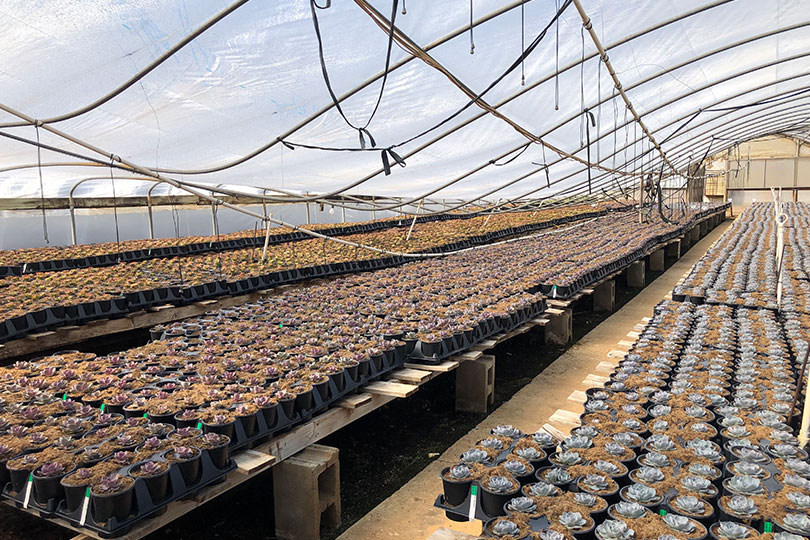By Jennifer Whitlock
Field Editor
February’s winter storms set back many sectors of Texas agriculture, but one area that was particularly hard-hit was the greenhouse and nursery industry.
This was expected to be a good marketing year for growers of commodities like turgrass, trees, shrubs and nursery plants, according to John Begnaud, a retired Texas A&M AgriLife Extension Service horticulturalist in San Angelo.
“There could be some challenges this year for inventory. Wholesale growers usually plan years in advance what kind of plant materials need to be planted and how much,” Begnaud said in an interview with the Texas Farm Bureau Radio Network. “When COVID-19 came along, people switched from going to the office to working and staying home and doing all these home projects, and landscape projects in particular. So, we saw this as one of the best years for the retail nursery industry that we’ve had in years because people are going out shopping and buying plant materials for their homes and gardens.”
But now, Texas growers may be struggling to produce plants for customers this spring.
Many areas of the Lone Star State don’t often see freezing temperatures or long periods of extreme cold, so Winter Storm Uri wreaked extreme havoc on plant materials selected without those types of conditions in mind. It can take years to get some varieties of shrubs to marketable size, Begnaud explained.
Growers with plants close to sale size are now at a major loss.
“If you consider the lag time to reach a five-gallon shrub, you don’t get that in one year’s time. You might plant cuttings, get the cuttings up, and have one-gallon plant material available in a year on some varieties of shrubs,” he said. “But sometimes it’s three to four years before you can get a two- to five-gallon shrub like most people would want to purchase.”
In East Texas, greenhouse and nursery growers were devastated.
Greenhouses collapsed and heat sources were shut off when areas lost electricity. Those who did manage to keep the heaters running are facing massive natural gas bills.
In Cherokee County, where greenhouse and nursery industry sales total about $65 to $70 million annually, the situation is dire. Aaron Low, Cherokee County Farm Bureau president and Texas A&M AgriLife Extension Service county agent, said the area’s economy is highly dependent on those products and is facing a massive crisis.
“The greenhouses weren’t insured. The plants weren’t insured, and it’s going to hit everybody pretty hard,” he said. “Some growers were able to keep their houses warm, but they didn’t realize natural gas prices had gone up exponentially overnight. Now, they’re dealing with that.”
One area grower received a gas bill of $278,000 for the month of February. Low said the man told him he went back through historical data for the past 15 years and February’s natural gas costs averaged about $23,000 for the month.
Another larger grower whose gas bill averages around $100,000 per month in the winter received a bill totaling $1.2 million.
“Normally, they said they pay a little over $2 per unit, and during the freeze, they shot up to over $100 per unit without anyone knowing. It was predominantly the three days during the freeze when prices skyrocketed because of the demand with the power grid and how all that’s tied in,” he said. “It was just one blow after another for these growers, and nobody knows what to do. We’ve turned to our legislators for some answers because no one is sure if this is price-gouging. Is it illegal? No one knows yet.”
Low estimated the county’s greenhouse growers are facing $15 to $20 million in plant loss alone, with a conservative $10 million estimate in structure losses.
Most of the county’s greenhouse and nursery businesses are family-owned, Low noted. They employ thousands of residents who have few other job prospects in the rural area.
Some growers will recover, while others said they may not be able to come back from such a massive blow.
Texas A&M AgriLife Extension Service economists say it’s still too early to put a number on damages to the nursery and greenhouse industry, but the dollar amount is expected to be astronomical.
“The green industry will experience increased labor, fertilizer and other costs as part of the price of replacing the plant material that was lost during the winter storm,” Marco Palma, Ph.D., horticultural marketing expert at Texas A&M University’s agricultural economics department, said in an interview with AgriLife Today. “It will take some weeks before we get a full picture of the immediate losses, but they will easily be in the tens of millions and probably in the hundreds of millions of dollars.”
AgriLife and the Texas Nursery and Landscape Association collaborated in February and March to develop and deploy a statewide loss assessment survey to help understand the scope of damages. Survey results will hopefully be used by U.S. Department of Agriculture and other governmental entities to create assistance programs for stakeholders affected by the storm.

